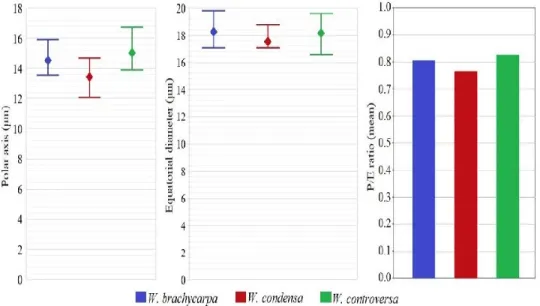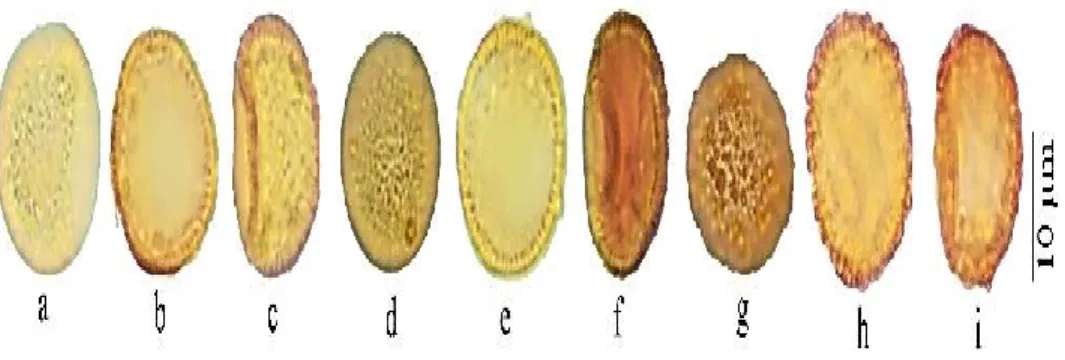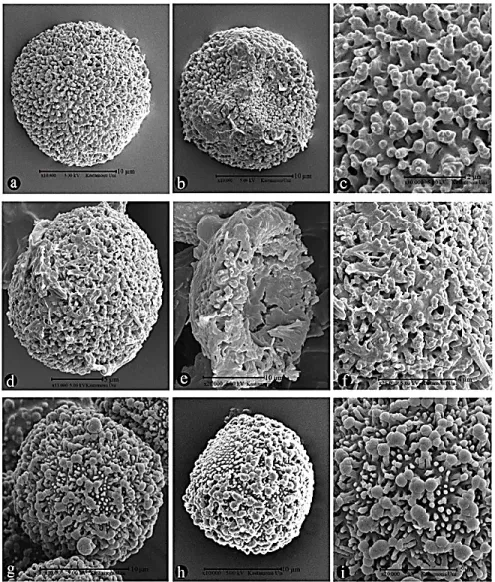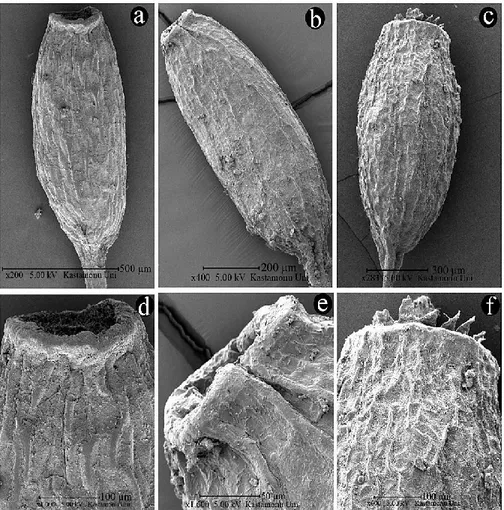DOI: 10.1501/commuc_0000000214 ISSN 1303-6025 E-ISSN 2651-3749
http://communications.science.ankara.edu.tr/index.php?series=C
Received by the editors: November 13, 2018; Accepted: November 30, 2018.
Key word and phrases: Pottiaceae, Weissia, spores morphology, capsule structure, SEM Submitted via II. Aerobiology and Palynology Symposium 07-10 October 2018 (APAS 2018)
© 2018 Ankara University Communications Faculty of Sciences University of Ankara Series C: Biology SPORE MORPHOLOGY OF SOME WEISSIA SPECIES (POTTIACEAE)
FROM TURKEY
MERVE CAN GOZCU, GURAY UYAR AND TALIP CETER
Abstract. In this study, spore morphology of Weissia controversa Hedw., W.
condensa (Voit) Lindb. and W. brachycarpa (Nees & Hornsch.) Jur. were examined
by the light microscopy (LM) and the scanning electron microscopy (SEM). All spores are small, the length of the polar axis (P) is between 13.39 µm and 15.0 µm, equatorial diameter (E) is between 17.56 µm and 18.38 µm. The smallest spores observed in W. condensa and the biggest spores in W. controversa. The shapes of all spores were determined as suboblate. Ornamentations are differing on leptoma and on distal pole. Baculate, baculate-clavate, pilate-baculate and ecinate ornamentation types were observed on the distal pole. The ornamentations are diluted on the leptoma. In addition to spore morphology, capsule structures were examined and photographed with SEM. As a result, the spore size, shapes, ornamentation types and the capsule structures show some differences among these species and these differences can be used as a distinctive character in the identification of the species.
1. Introduction
The Pottiaceae Hampe is the most common and large moss family, with around 1.400 species in 83 genera. This family members show a major variety of morphological, physiological and genecological adaptations [1]. Pottiaceae is one of the lineages in which most exchanges in sporangium shape [2].
Weissia Hedwig, belonging to Pottiaceae family, is one of the most notable genus where a shift in both sporangium shape and habitat is seen [2]. Weissia is a large genus with about 100 species worldwide and generally contains widely spread species whose relationships have been much debated [1, 3]. The genus is presented with 12 taxa in Turkey; Weissia brachycarpa (Nees & Hornsch.) Jur., W. breutelii Mull.Hal., W. condensa (Voit)Lindb. var. condensa, W. condensa var. armata (Thér.&Trab.) M.J.Cano, Ros & J.Guerra, W. controversa Hedw. var. controversa, W. controversa var. crispata (Nees&Hornsch.) Nyholm, W. leptocarpa Schimp. ex Besch., W. levieri (Limpr.) Kindb., W. longifolia Mitt., W. rutilans (Hedw.) Lindb., W. squarrosa (Nees&Hornsch.) Mull.Hal., W. wimmeriana (Sendtn.) Bruch& Schimp. [4, 5]. In many species of Weissia, the gametophyte characters such as the
the sporophyte characters such as seta length, operculum and peristome teeth development are strikingly variable [3]. These conclusions show the potential for the genus to be used as a model organism for examining morphological variation in moss sporophyte. Spore, which is an important sporophytic characters, has also been useful in solving taxonomic problems. Some recent studies have proved that spore external morphology is useful in characterizing moss taxa at the generic and specific levels [6-14]. For this reason, in this study, the
detailed spore morphological structures of some Turkish Weissia species were studied with light microscope (LM) and scanning electron microscope (SEM), in order to contribute to the taxonomy and palynology works. In addition to spore morphology, capsule structures were examined and photographed with SEM.
2. Material And Methods
The spore and capsule materials were obtained from the bryophyte herbarium of Ankara Hacı Bayram Veli University Polatlı Science and Arts Faculty. List of spores examined are given in the Table 1. The external surfaces of the spores were observed using light microscopy (LM) and scanning electron microscopy (SEM). The spores were prepared by the Wodehouse [15] method for LM photographs. The measurements of the polar axis (P) and the equatorial diameter (E) were taken from 20 randomly selected spores. The Simpson and Roe graphical test was used for graphical calculations [16]. The capsules were observed using stereo microscopy and scanning electron microscopy. The mouth diameter, length and width in 20 randomly selected capsules were measured. Olympus SZX7 model light microscope, BX47 model stereo microscope and SC 100 Model image analysis system were used to photograph and measurements the spores and the capsules.
For scanning electron microscopy, the spores and the capsules were directly placed onto stubs which have double-sided carbon band. The stubs were coated with gold-palladium alloy at voltage of 40 mV for 60 seconds in a vacuum evaporator and examined with Quanta Feg 250 scanning electron microscopy in Kastamonu University Central Research Laboratory.
The terminology for spore morphology was proposed by Erdtman [17], Boros and Járai-Komlódi [18], Blackmore and Barnes [19], Punt et al. [20] and Kapp et al. [21].
TABLE 1. The details of specimens and localities.
Species Localities
Weissia controversa
Sakarya (Karapürçek); on soil, Pinus nigra J.F.Arnold, Quercus L.,
Juniperus L. forest, 1005 m alt., 40°35'45''N, 30°32'37''E, 12.05.2018. Weissia condensa
Yalova (Central); on soil, Carpinus betulus L., Fagus orientalis Lipsky,
Tilia tomentosa Moench forest, 485 m alt., 40°32'02''N, 29°12'40''E,
11.05.2018.
Weissia brachycarpa
Kocaeli (Başiskele); on soil, Carpinus betulus L., Cornus mas L., Juglans
regia L., Erica arborea L. forest, 182 m alt., 40°40'01''N, 29°58'42''E,
12.05.2018.
3. Results
Weissia brachycarpa: Spores are small, suboblate, heteropolar and katalept. The length of the polar axis is average 14.76 µm, equatorial diameter is average 18.38 µm in diameter, the ratio of polar axis to equatorial diameter is ~0.80 (Table 2, Figure 1). The sclerine surface is ornamented by regular baculate-clavate elements. Baculas have papillae. Both elements are irregular in size, between 0.5-1.0 µm long. The aperture consists of irregular leptoma. Leptoma boundaries are not clear, monolete (Figure 2, 3). The capsules are erect, ovoid, symmetrical, average 0.48 mm wide and 1.26 mm long, ~2.6 times as long as wide. The capsule mouth narrowed and is average 0.22 mm in diameter. Peristome absent (Figure 4).
TABLE 2. The spore morphological parameters (values in μm).
Species min max mean min max mean P E (mean) P/E Shape Ornamentations
W. brachycarpa 13.57 15.93 14.76 17.03 19.84 18.38 0.80 Suboblate Baculate-clavate
W. condensa 12.03 14.68 13.39 17.03 17.75 17.56 0.76 Suboblate Baculate
W. controversa 13.89 16.77 15.0 16.57 18.21 18.21 0.82 Suboblate Pilate-baculate, microechinate
Weissia condensa: Spores are small, suboblate, heteropolar and katalept. The length of the polar axis is average 13.39 µm, equatorial diameter is average 17.56 µm in diameter, the ratio of polar axis to equatorial diameter is ~0.76 (Table 2, Figure 1). The sclerine surface is ornamented by irregular baculate elements with papillae. Baculas are irregular in shape and size, between 0.3-1.0 µm long. The aperture consists of a concave leptoma. The ornamentations are diluted on leptoma (Figure 2,
0.82 mm long, ~2.8 times as long as wide. Capsule mouth distinctly narrowed and is average 0.13 mm in diameter. Peristome absent (Figure 4).
FIGURE 1. Graphical comparison of the length of polar axis (P), equatorial diameter (E) and P/E rotations (minimum, maximum and mean values).
Weissia controversa: Spores are small, suboblate, heteropolar and katalept. The length of the polar axis is average 15 µm, equatorial diameter is average 18.21 µm in diameter, the ratio of polar axis to equatorial diameter is ~0.82 (Table 2, Figure 1). The sclerine surface is ornamented by pilate-baculate and microechinate elements. These elements are irregular in shape and size, between 0.2-2.0 µm long. The aperture consists of an undistinct, slightly concave to plano-convex leptoma. Leptoma surface is ornamented with microecinate elements. The ornamentations are diluted on leptoma (Figure 2, 3). Capsules are erect, ovoid, symmetrical, average 0.51 mm wide and 1.14 mm long, ~2.2 times as long as wide. The capsule mouth narrowed slightly and is average 0.31 mm in diameter. Peristome present, teeth rudimentary, lanceolate, slightly papillose, striate, ~55 µm long (Figure 4).
FIGURE 2. LM spore microphotograph. a-c: W. brachycarpa; d-f: W. condensa; g-i: W.
controversa (a, d, g: distal view; b, e, h: proximal view; c, f, i: equatorial view).
4. Discussion
The spore morphology of Turkish Weissia controversa, W. condensa and W. brachycarpa species studied by LM and SEM. Among them, the spores of W. controversa have previously been described by Boros et al. [22]. The results presented here are in accordance with this study. However, discrepancies that have not previously been referred to in the literature, specifically relating to surface ornamentation in W. condensa and W. brachycarpa, were observed during the present study.
The species have small sized spores and common sporophytes that increase chance of successful dispersal and occupying new localities [23]. The length of the polar axis (P) is between 13.39 µm and 15 µm, equatorial diameter (E) is between 17.56 µm and 18.38 µm. The smallest spores of them are Weissia condensa and the biggest spores of them are W. controversa. The shapes of all spores were determinedas suboblate. Spore walls are thick on distal pole, tapers to proximal pole and forms leptoma. All spores are katalept and heteropolar. While W. brachycarpa has monolete spores, W. controversa and W. condensa have alete spores. Apertures are in the form of a leptoma on the proximal pole. The shape of leptoma varies from concave to plano-convex. The ornamentations are differing on leptoma and on distal pole. Baculate, baculate-clavate, pilate-baculate and ecinate ornamentation types
species. The ornamentations are diluted on the leptoma.
FIGURE 3. SEM spore photograph. a-c: W. brachycarpa, d-f: W. condensa; g-i: W.
FIGURE 4. SEM capsule photograph a, d: W. brachycarpa, b, e: W. condensa; c-f: W.
controversa.
There is some relationship between exine surface ornamentations and the vegetation substratum [6, 13]. Examined moss species are belonging to only one habitat; terricolous that inhabited on soil. In this study, the species, which have baculate exine surfaces, prefer terricolous habitats.
capsules are between 0.29 mm and 0.51 mm, length of capsules are between 0.82 mm and 1.26. mm. The smallest capsules are in Weissia condensa. All capsules are erect and symmetrical. While W. controversa has rudimentary, lanceolate, slightly papillose peristome teeth, W. condensa and W. brachycarpa have not peristome. According to the results; scanning electron microscopy images are an important character in the differentiation of species, while light microscope images do not provide a precise distinction.
Consequently, the spore morphology and capsule structures in examined Weissia species show distinctive features which are important for taxonomic studies.
References
[1] R. Zander, Genera of the Pottiaceae: Mosses of harsh environments. Bulletin of the Buffalo Society of Natural Sciences, 32, (1993) 1-378.
[2] Y. Tsubota and H. Inoue, A taxonomic revision of cleistocarpous species of Weissia (Pottiaceae, Bryophyta) in Japan. Phytotaxa, 306, (2017) 1-20. [3] B. Lemmon, Cytological Investigations in the genus Weissia in Southeastern
United States. Ph.D Thesis, Louisiana State University, (1968).
[4] G. Uyar and B. Cetin, A new check-list of the moses of the Turkey. Journal of Bryology, 26, (2004) 203-220.
[5] A. Erdag and H. Kurscher, Türkiye bitkileri listesi (Karayosunları). Ali Nihat Gokyigit Vakfı, Flora Araştırmaları Dernegi, (2017), İstanbul.
[6] R. Khoshravesh and S. Kazempour Osaloo, Spore morphology of certain mosses of northern Tehran-Iran: taxonomical and ecological implications. Iran Journal Botany, 13(2), (2007) 150-159.
[7] I. Potoglu Erkara and F. Savaroglu, Spore morphology of some Brachytheciaceae Schimp. species (Bryophyta) from Turkey. Nordic Journal of Botany, 25, (2007) 194-198.
[8] F. Savaroglu, I. Potoglu Erkara, C. Baycu and M. Alkan, Spore morphology of some Bryaceae Schwägr. species (Bryophyta) from Turkey. International Journal of Natural and Engineering Sciences, 1(2), (2007) 49-54.
[9] F. Savaroglu and I. Potoglu Erkara, Observations of spore morphology of some Pottiaceae Schimp. species (Bryophyta) in Turkey. Plant Systematics and Evolution, 271, (2008) 93-99.
[10] N. Medina, B. Estebanez, F. Lara and V. Mazimpaka, On the presence of dimorphic spores in Orthotrichum affine (Bryopsida, Orthotrichaceae). Journal of Bryology, 31, (2009) 127-129.
[11]. B. Ascı, T. Ceter , N. Pınar, H. Çolgeçen and B. Cetin, Spore morphology of some Turkish Tortula and Syntrichia species (Pottiaceae Schimp., Bryophyta). The Herb Journal of Systematic Botany, 1(2), (2010) 165-180. [12] I. Caldeira, A. Luizi-Ponzo and V. Esteves, Palynology of selected species of
Fissidens (Hedw.). Plant Systematics and Evolution, 299, (2013) 187-195. [13] F. Savaroglu, Spore morphology of some Orthotrichaceae Arn. species
(Bryophyta) from Turkey. Bangladesh Journal of Botany, 44(4), (2015) 499-506.
[14] T. Ceter and K. Canlı, Türkiye’de yayılış gösteren bazı Grimmia (Grimmiaceae, Bryophyta) türlerin spor morfolojisinin incelenmesi. III. Aerobiyoloji, Palinoloji ve Alerjik Hastalıklarda Son Yenilikler Sempozyumu (APAS 2016), 5-7 Kasım 2016, Kastamonu / Türkiye, (2016).
[15] R. Wodehouse, Pollen grains. Mc. Grew Hill, (1935) New York.
[16] A. Van der Pluym and M. Hideux, Application d’une mèthodologie quantitative á la palynologie d’Eryngium maritimum (Umbelliferae). Plant Systematics and Evolution, 127, (1977) 55-85.
[17] G. Erdtman, Pollen and spore morphology/plant taxonomy; Gymnospermae, Pteridophyta, Bryophyta. Almquist and Wiksell, (1957), Stockholm.
[18] A. Boros and M. Járai-Komlódi, An Atlas of recent European Bryophyte spore. Akademiai Kiado, (1993) Budapest.
[19] S. Blackmore and S. Barnes, Pollen and Spores. Patterns of Diversification. The Systematics Association. Special Vol. No. 44. Clarendon Press, (1991), Oxford.
[20] W. Punt, S. Blackmore, S. Nilsson and A. Le Thomas, Glossary of pollen and spore terminology, contributions series No:1. LPP foundation, (1994), Netherlands.
[21] R. Kapp, O. Davis and J. King, Pollen and spores, the American association of stratigraphic palynologists foundation. Texas A&M University, (2000), USA.
[22] A. Boros, M. Járai-Komlódi, Z. Toth and S. Nilson, An atlas of recent European bryophyte spores. Akademiai Kiado, (1993), Budapest.
[23] H. Kurschner, Life strategies and adaptations in Bryophytes from the Near and Middle East. Turkish Journal of Botany, 28, (2004) 73-84.
Current Address: MERVE CAN GOZCU, Ankara Hacı Bayram Veli University, Polatlı Faculty of Science and Arts, Department of Biology, Ankara, Turkey. E-mail: mcgozcu@gmail.com
ORCID: https://orcid.org/0000-0001-7935-6314
Current Address: GURAY UYAR, Ankara Hacı Bayram Veli University, Polatlı Faculty of Science and Arts, Department of Biology, Ankara, Turkey.
E-mail: gurayuyar@hotmail.com ORCID: https://orcid.org/0000-0003-4038-6107 Current Address: TALIP CETER, Kastamonu University, Faculty of Science and Arts, Department of Biology, Kastamonu, Turkey.
E-mail: talipceter@hotmail.com
ORCID: https://orcid.org/0000-0003-3626-1758



